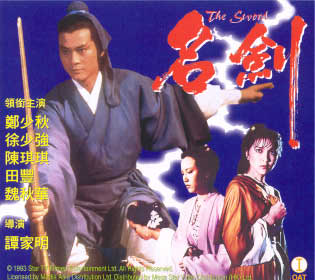The Sword

Director: Patrick Tam
Year: 1980
Rating: 8.0
Though Patrick Tam
is considered one of the leading directors of what has been termed “The New
Wave” movement of the early 80’s in Hong Kong, his debut film, The Sword,
actually seems to look backwards rather than forwards. Almost as if the kung
fu and ultra violent Chang Cheh sword-fighting films had not existed, The
Sword seems to immerse itself nostalgically in the mood and style of the
classical wuxia films of the 60’s and early 70’s

It has certain modernistic inflections – the hero has shades of gray about
him, the cinematography utilizes some intriguing angles and transposition
shots, a fabulous fade to red – but overall the film could easily be viewed
alongside the films of King Hu. Like Hu, Tam has an incredible eye for detail,
elitist artistic and cultural sensibilities and he uses the camera to paint
scenes as much as film them. The film is beautifully shot – each frame looking
meticulously planned out – and it generates a cool, urbane, formal and very
aesthetic feel to it. It is the type of film in which one of the characters
gently sips tea – excuses themselves – and goes off to commit suicide in a
wordless display of honor and tact. To some degree this drains the passion
out of the film – but it is so well filmed that I found it completely engrossing.
It is almost as if Tam had to create this film – a homage perhaps to the classical
films that he grew up with – before he could move on to the more experimental
films that were to follow.

Before I make this sound like a dull walk through a beautiful art gallery,
I have to mention that the action scenes – of which there are many – are incredibly
entertaining. Again to a large extent they forego the extreme violence of
the then contemporary films – but the sword fighting choreography is stunning
and imaginative. Much of the credit for this must go to Ching Siu-Tung who
choreographs the action with such verve and panache that much of it made
me smile at the simple pleasure of watching it. Mixing the graceful clashing
of swords with the measured use of trampolines and wires make it a visual
candy store. Much of what Ching brings to this film, he utilizes later in
his groundbreaking Duel to the Death.

Adam Cheng (who had just become a star for his turn in a TV series called
The Story of Book and Sword and was to star in many sword films) is roaming
the Chinese countryside looking for the retired Master Wah (Tien Feng) who
is a legendary swordsman. He runs across a young, spirited woman who is being
chased after by a nasty looking killer (Lee Hoi-sang) and he helps her out
– though she is a fine swordswoman in her own right. Afterwards they decide
to accompany each other in their travels – but Cheng soon crosses paths with
his old girlfriend, Hsiao Yue (Chen Chi Chi), and the viewer learns
that Cheng left her ten years ago to begin his obsessive odyssey like search
for Master Wah.

Hsiao Yue is now married to Norman Tsui who is a nasty piece of work. His
right hand man is Eddie Ko – a ninja like assassin with total dog like loyalty
to his master. Tsui doesn’t appreciate the fact that the old boyfriend to
his wife is around and orders Ko to kill him. This is one of three terrific
duels between Cheng and Ko that are suspenseful and edgy. Ching Siu Tung has
Ko scuttling along the floor, moving in the shadows and hiding on the ceiling
in splendid fashion as he tries to kill Cheng.

Finally, Cheng finds Master Wah, but his intentions are not what you expect
– and though Cheng is basically an honorable fellow his actions begin a series
of events that lead to tragedy and death for many of the characters. In the
end he must face Norman Tsui and this final duel is an incredible display
of cinematic and physical artistry as they fight to the last drop of blood
and the final look of horror by Cheng at what he has wrought is a classic
shot.








